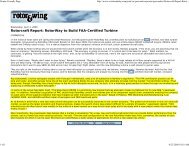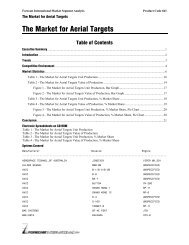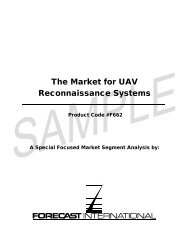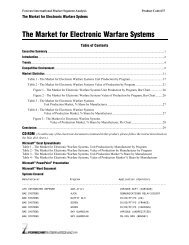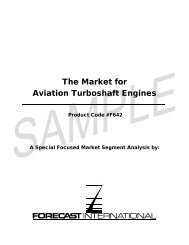The Market for Medium/Heavy Military Rotorcraft - Forecast ...
The Market for Medium/Heavy Military Rotorcraft - Forecast ...
The Market for Medium/Heavy Military Rotorcraft - Forecast ...
Create successful ePaper yourself
Turn your PDF publications into a flip-book with our unique Google optimized e-Paper software.
Product Code F603 <strong>The</strong> <strong>Market</strong> <strong>for</strong> <strong>Medium</strong>/<strong>Heavy</strong> <strong>Military</strong> <strong>Rotorcraft</strong><br />
At least <strong>for</strong> another few years, the medium/heavy<br />
segment of the military rotorcraft market will be able to<br />
maintain the steady growth track that it has followed in<br />
recent years. However, the era of sustained market<br />
growth is coming to an end. Build rates can be expected<br />
to start declining as soon as 2014, and then continue<br />
declining through the remainder of the <strong>for</strong>ecast period.<br />
Our projections <strong>for</strong> the medium/heavy segment indicate<br />
that annual production will total 418 units in 2011, rise<br />
to 504 units by 2013, and then start a gradual but steady<br />
decline. Yearly output is expected to total only 366<br />
units in 2020.<br />
One of the primary market drivers in the segment has<br />
been the continuing high level of acquisition of<br />
medium/heavy rotorcraft by the U.S. armed services.<br />
As the U.S. represents a very large portion of the world<br />
market <strong>for</strong> such machines, U.S. procurement levels tend<br />
to have a substantial influence on the shape and scope of<br />
the global market.<br />
<strong>The</strong> U.S. is not the only nation that has ramped up<br />
military helicopter acquisition in recent years. <strong>The</strong><br />
nature of present-day military conflict calls <strong>for</strong> heavy<br />
reliance on the use of rotary-wing assets. Not<br />
coincidentally, the medium/heavy military rotorcraft<br />
market has witnessed an influx of new products,<br />
production ramp-ups of which are helping to drive<br />
overall production levels in the segment.<br />
Nevertheless, both in the U.S. and elsewhere, many of<br />
these acquisition programs will soon run their course.<br />
<strong>The</strong> result is that, by the second half of the <strong>for</strong>ecast<br />
period, annual production in the medium/heavy military<br />
market will be declining. Very few nations are<br />
embarking on major new procurement programs <strong>for</strong><br />
such rotorcraft.<br />
Thus, by 2014 or so, the current procurement cycle will<br />
be nearing an end. Many of the new rotorcraft models<br />
developed in past years will have already been in<br />
production <strong>for</strong> several years.<br />
<strong>The</strong> medium/heavy military rotorcraft market comprises<br />
a number of submarkets such as attack helicopters,<br />
transport/utility, anti-submarine warfare (ASW), searchand-rescue,<br />
and so <strong>for</strong>th. Most of the products currently<br />
sold on the market compete in more than one of these<br />
subsegments. Many are marketed in a variety of<br />
versions and configurations that are individually tailored<br />
<strong>for</strong> use in specific roles. This broadens the market<br />
appeal of a helicopter product family, and can also assist<br />
a military customer in achieving fleet consolidation and<br />
rationalization.<br />
Introduction<br />
©2011<br />
Multirole capability is there<strong>for</strong>e an important attribute<br />
<strong>for</strong> a medium/heavy rotorcraft in the military<br />
marketplace. Thus, when it comes to analyzing and<br />
<strong>for</strong>ecasting the medium/heavy segment, a<br />
methodological approach is required that, at least to<br />
some extent, can look beyond the various submarkets.<br />
While these submarkets need to be considered and<br />
evaluated, they must be seen in correlation with each<br />
other and not treated as isolated and discrete elements.<br />
Methodology. <strong>Forecast</strong> International generally<br />
defines a medium/heavy rotorcraft as having a<br />
maximum gross weight greater than or equal to 6,804<br />
kilograms (15,000 lb). <strong>Rotorcraft</strong> with a gross weight<br />
of less than 15,000 pounds are generally defined as light<br />
rotorcraft.<br />
In applying these definitions to the current range of<br />
products on the rotorcraft market, however, we allowed<br />
ourselves some leeway. Our goal was to group together<br />
directly competing products as much as possible, and a<br />
too-strict application of our gross-weight-based<br />
definitions would interfere with this. So, a few<br />
exceptions were made, and we placed some models in<br />
the opposite class than would seem to be indicated by<br />
their weight. For example, the Bell UH-1Y, despite its<br />
gross weight of 18,500 pounds, has been categorized <strong>for</strong><br />
our purposes as a light rotorcraft since much of its direct<br />
competition is found in the light class.<br />
Besides year-by-year production <strong>for</strong>ecasts <strong>for</strong> individual<br />
rotorcraft models, this study also includes manufacturer<br />
market share projections. In calculating such<br />
projections, joint ventures and other types of industry<br />
teams are treated as separate entities from the individual<br />
firms that make up their membership. Thus, the market<br />
shares of the Bell/Boeing V-22 team are calculated<br />
independently from either Bell or Boeing. This avoids<br />
the problem of having to apportion the shares among the<br />
various team members.<br />
Included in this market analysis are production <strong>for</strong>ecasts<br />
<strong>for</strong> the following rotorcraft families:<br />
AgustaWestland AW101<br />
Bell/Boeing V-22<br />
Boeing AH-64 Apache<br />
Boeing CH-47 Chinook<br />
Eurocopter AS 532/EC 725<br />
KAI Korean Utility Helicopter<br />
Kamov Ka-28/29/31<br />
Kamov Ka-50/52<br />
Mil Mi-8/17<br />
Mil Mi-24/25/35<br />
Continued…



